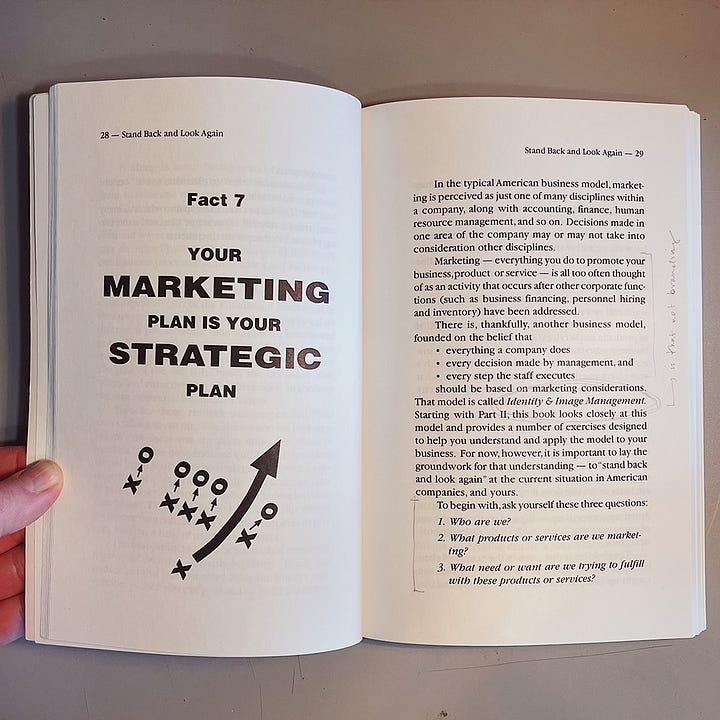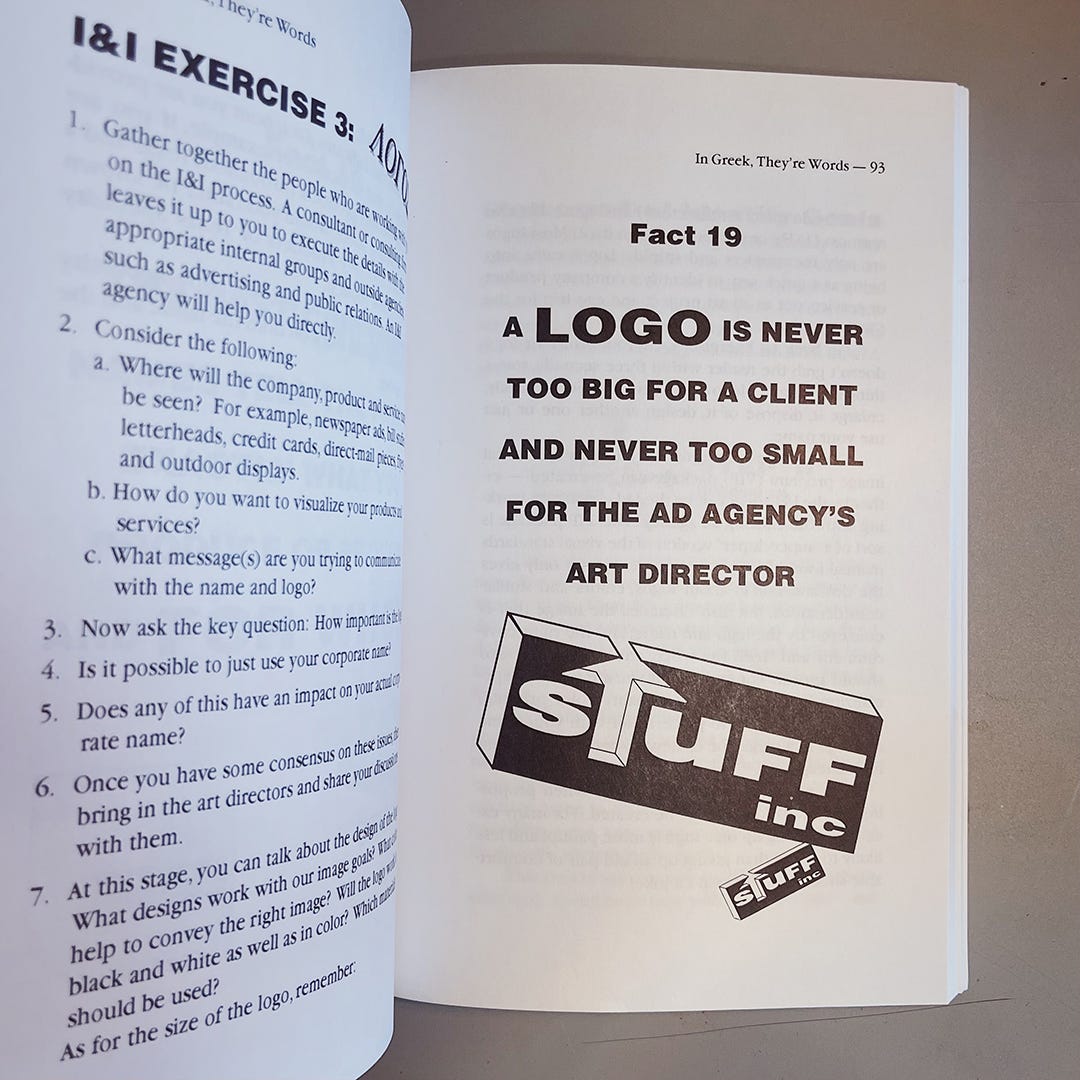xx035 • Advertising has always been a waste of money
But, when did we start calling it 'branding'?
1994 was a year of transitions for my family. After more than two decades together—including multiple moves across state lines, a marriage, two kids, several companies, and a fresh divorce—my parents were starting to build separate lives. My mom returned to work in education, leaving the creative agency they co-founded for my dad to run solo. Meanwhile, he was falling in love and buying a house with the man who would become my step-father; my younger brother and I were getting to know our new step-brother. I also turned 14, proclaimed my queerness, and started high school. It was a big year.
1994 was also a pivotal year for the internet—Amazon, Yahoo, CNET, and the first popular consumer browser Netscape were all founded.1 The Clinton Administration delivered on their campaign promise to invest in the 'information superhighway' by privatizing the internet infrastructure away from the government. (They also launched whitehouse.gov!) And on Aug 12, Phil Brandenberger typed in his credit card and made the first internet purchase—for a compact disc. (NYT: Attention Shoppers: The Internet is Open)
If you were online at all in 1994 you were likely dialing up from a PC at 28.8 kpbs into one of the 'Big Three' private computer networks: Prodigy, Compuserve, and America Online.2 (My phone just clocked 352 Mbps—ChatGPT told me that is more than 12,000 times faster and ‘a dramatic increase in speed’.) In our house, we only touched Macintoshes and had accounts with all the online services you've heard of and even the ones you haven't. The internet was rising over the horizon, but not everyone could see it yet.
My dad—Bob Ranson—always thought of himself as being on the cutting edge culturally and technologically. Before running an agency he had founded and sold two computer companies in the early 80s. In 1994, his agency (fka Corporate Visions, now Ranson Walsh & Associates) had scaled down and was located in the basement of our suburban townhouse. I would join him every day after school; peering over his shoulder and chatting up his employees. I can picture him sitting down at one of the many Macs we had down there and opening PageMaker to work on the first iterations of his book: ‘Advertising is a Waste of Money.’3 I have memories of binding early editions downstairs by hand; this copy has a 1994 copyright and was published by a small business press out of Amherst, MA.
I feel a deep connection to both the contents of my dad's book and his impulse to write it all down. It seems clear to me that my dad wrote the book as an exercise of reinvention. He was synthesizing lessons learned, attempting to make sense of the unknown future, and hopefully attracting new business. I can relate. Last week, I wrote about the gut punch of losing him too-early in my career. I often want to call him and talk out a challenge at work or collectively marvel at the latest tech release. This week, I reached for his book itching to hear his voice again and discover if any of his three-decades-old marketing advice still applies. I went looking for guidance, but I landed on a puzzle.


The book’s premise is that if you practice the ‘Identity & Image Management’ model—follow the 6-step-process, do the exercises, ask yourself all the questions—then you can more effectively reach your customers and therefore increase sales. Summarized around our dinner table: ‘advertising is a waste of money until you know who you are.’
My dad was a frequent purchaser of those glaring yellow ‘For Dummies’ books so ubiquitous in the 90s—his book is in that vein. I remembered the early-desktop publishing graphics full of ⇦ ⇨ ⇧ ⇩. I was amused by my dad's very particular, and now incredibly outdated, pop culture references. (Who makes Dick Cavett jokes anymore?!) I winced a little at the cheesy gimmick of using $ in chapter titles like ‘$mart Advertising’ and ‘$treet $mart Public Relations.
But, nearly 30 years later, the strategic advice at the core is sound:
The more you spend on advertising, the more you spend on advertising.
Advertising is only one of many tools to increase sales.
When you grab people by their emotions, their minds and wallets will follow.
You must give people a reason to buy—a reason that is real or perceived to be.
And this truism will never die…
The book has also clearly aged. At current internet speeds it often it feels like a century has past since 1994, Much of what marketers now obsess over hasn't been invented yet. Here is a short list of some of my favorite stressors as a Chief Marketing Officer that do not exist in the world of 1994: SEO, CRM, ESP, MMP, DAM... ALL of social media.
But there was one thing that felt conspicuously absent: the concept of branding.
In 162 pages on corporate 'identity & image' I read not a single use of the words 'brand' or 'branding'. The overall framework and perspective my dad outlines reads spiritually akin to the branding processes agencies now tout. And now we live in a world where branding is omnipresent—social media has led everyone and every entity online to consider their brand. Was my dad, who always saw himself one step ahead, actually out of touch with the moment? Or did the industry's lexicon change?
I went looking for an answer.
I called a friend who runs a design agency and already working in NYC in 1994. (She remarked that I was calling my old friend.) I summarized my dad’s book and got a fast answer: ‘No. We didn’t call it branding then.’ But she couldn’t pinpoint when the shift happened.
When I wrote about my career path last week I inadvertently left out an entire chapter: business school. I reached out to my former DMBA marketing professor Steve Diller and asked if my dad got it wrong.4 'I don't think he was "off," just a product of his times.' Steve continued…
My experience with ad agencies in the early 90s was that they were really at a peak of their influence in the marketing world. They were increasingly positioning themselves as strategists as opposed to "just" communicators....They tried to make this move because the typical client had no clue what their ads should really be doing, aside from increasing sales. The idea of an experiential "brand promise" simply wasn't understood by most companies or ad agencies in any meaningful way (yet). Looking back, my dad seems aligned with the moment. Right on the precipice of massive cultural change, he was offering his clients (and especially prospective clients) a series of prompts for rethinking their business assumptions. The opening lines of my dad’s introduction acknowledges the change in the air—he references Bob Dylan and states that ‘the present decade bears little resemblance to the three decades that proceeded it.’ We are right at the beginning of wide-scale consumer adoption of AI-fueled products and services. His sentence is describing right now.
But the Anthropology grad in me is still stuck on the vocabulary. Throughout the book my dad refers to ‘corporate identity’ and ‘corporate image’. His definitions distinguish between between internal and external sentiment:
corporate identity = the way a company thinks about itself
corporate image = the way a company is viewed by the public
There’s a full-page graphic asserting:
Your corporate identity is your company’s most important asset
If he wrote that today, I would expect it to read:
Your brand is your company’s most important asset
But ‘brand identity’ does not mean exactly what ‘corporate identity’ did. In 1994, corporate identity was an internal sense of self. By the 2018 5th edition of Designing Brand Identity (Wheeler) ‘brand identity’ is a much broader, more holistic concept: ‘Brand identity is tangible and appeals to the senses. You can see it, touch it, hold it, hear it, watch it move.’ This is the ‘experiential brand promise’ Steve was pointing to.
I kept searching for the pivot point and fell down a rabbit hole of the American Marketing Association’s journal archives. In 1994 the AMA published a Special Issue on Brand Management which included articles on 'The Importance of the Brand in Brand Extension' and 'Brands, Brand Management, and the Brand Manager System: A Critical-Historical Evaluation'—but again, no use of the word ‘branding’.5 You’ll be delighted to know this issue did include a multi-page review of Powerpoint for Windows and its competitors—anyone remember Statgraphics Plus?
After more than a week of chasing the answer to this admittedly esoteric question it occurred to me late at night editing this piece that I fell for my own red herring. Does it matter when we all started calling it ‘branding’? Or was I just trying to talk to my dad’s ghost? The irony of course is that were he alive there’s no doubt in my mind he would have an immediate answer. (And at least 80% of it would be true...) My quest did lead to a long conversation with my brother about the nuance between ‘corporate image’ and ‘corporate reputation.’ My brother grew up to be a very successful PR exec. We both learned the family business.
But not one to quit a research project without feeling satisfied, I tried one more angle: searching Amazon for books published before 2000 that included the word ‘branding’. I found ‘Brands: The New Wealth Creators’ edited by Sussanah Hart and John Murphy for Interbrand. The 1998 paperback edition’s back cover begins:
Branding is currently one of the most exciting subjects around; business people everywhere are waking up to the fact that brands are a huge source of value....the techniques of good branding are just as vital in the business-to-business and utilities sectors, and are increasingly being applied even in non-commercial areas, from charities to football clubs. Maybe this is the moment?
Have a piece of the puzzle to contribute? Something I overlooked? Please share below in the comments or reply back via email.


Congratulations to my friend and former Compass colleague Leah Smart whose show ‘In the Arena’ just won the Signal Award for Most Inspirational Podcast. If you too hope for better humans, better work, and a better world I rec tuning in. Thank you Leah for the motivating texts and book suggestions this week.
Thank you Steve Diller for your incredibly thoughtful and rapid response to my inquiry.
Thank you all for reading this far. Last week’s newsletter came together relatively easy, this followup was much more painful. Appreciate all of you for the kind words and encouraging feedback.
Moving forward with a weekly Tuesday schedule. See you then.
In a funny convergence of the universe, CNET founder Halsey Minor—and fellow UVA Anthropology grad—infamously donated a lot of money, and then didn’t, to our alma mater.
https://timesmachine.nytimes.com/timesmachine/1994/11/29/960470.html?pageNumber=60s
1994 also happens to be the year Adobe Systems acquired Aldus Corporation and it’s flagship software package PageMaker (for $446M!) in order to compete with QuarkXPress.
In the late 2000s, I was deeply invested in my career at Pixar but eager to learn outside our campus walls. After considering UC Berkeley’s Haas School of Business I heard about a brand new MBA in Design Strategy launching at the California College or the Arts. I had the great pleasure of joining their ‘pioneering’ first cohort.
Vol. 31, No. 2, May, 1994 Journal of Marketing Research Published by: Sage Publications, Inc. on behalf of American Marketing Association https://www.jstor.org/stable/i358154





